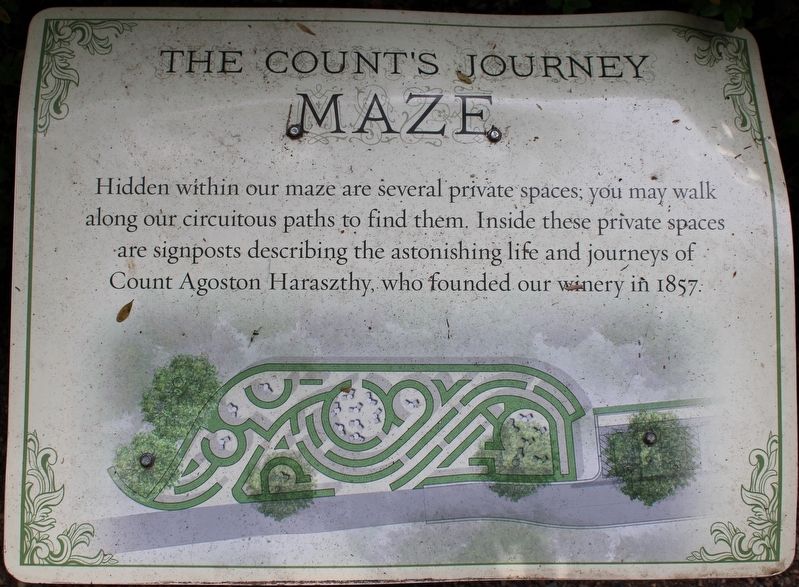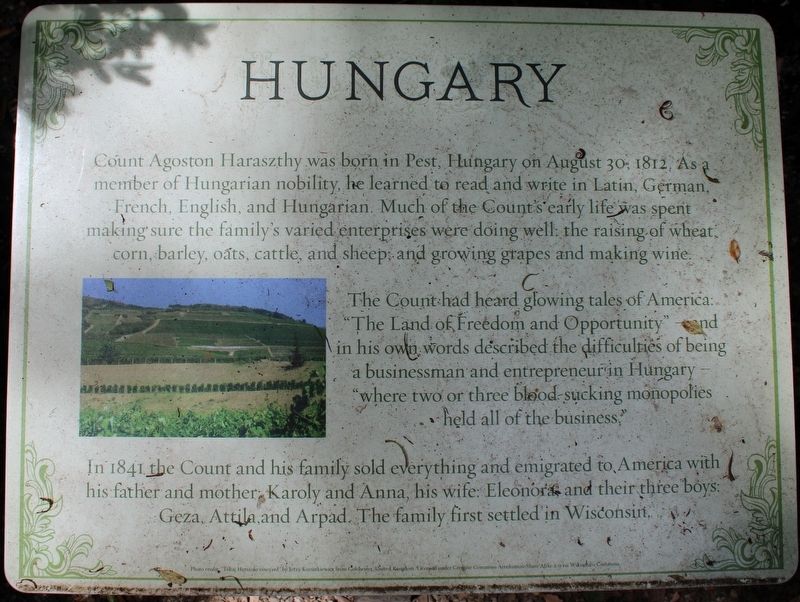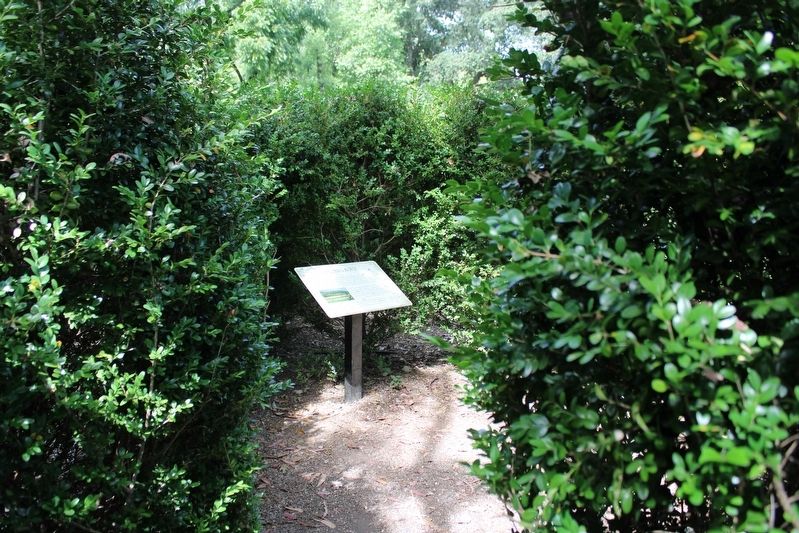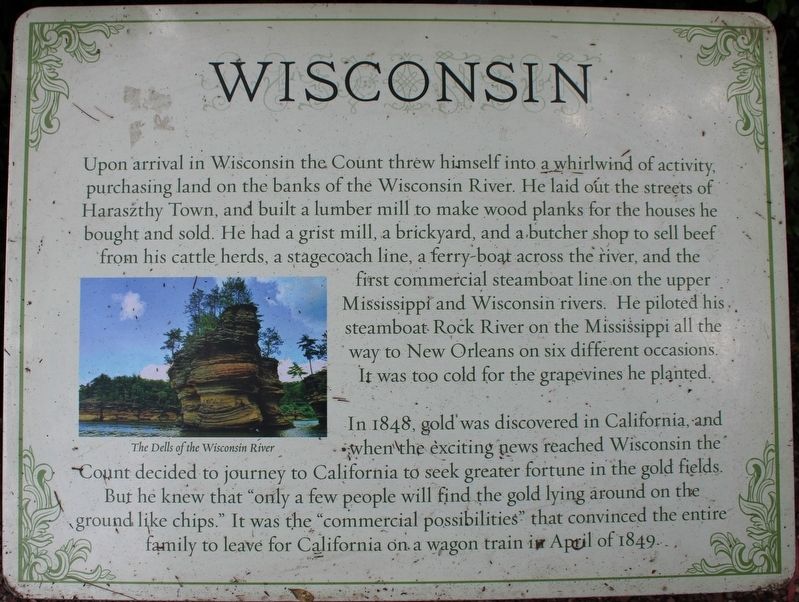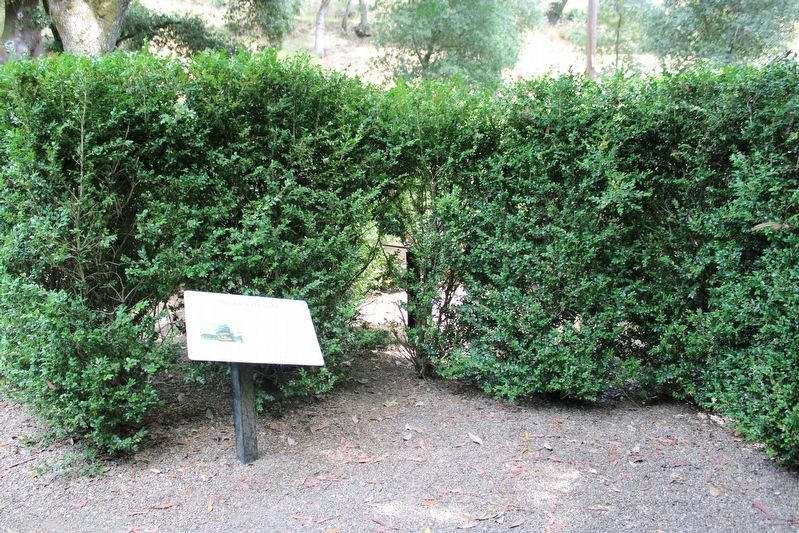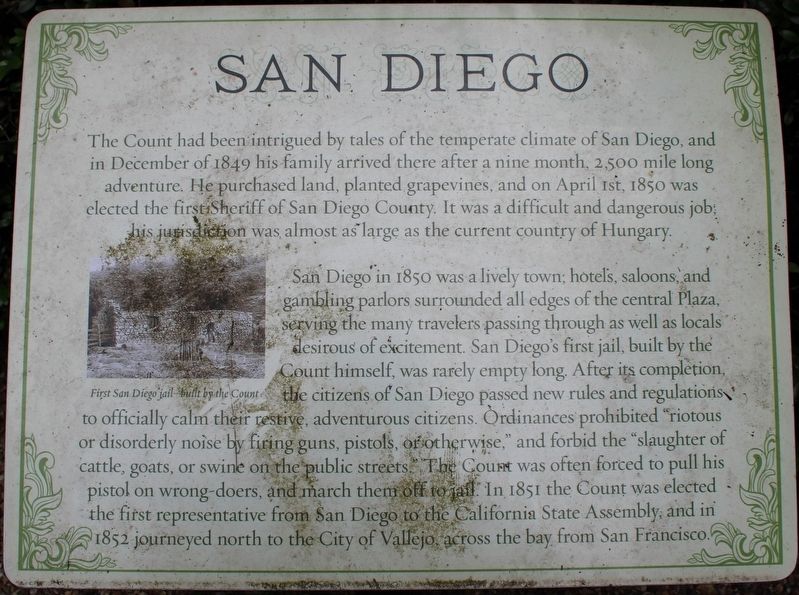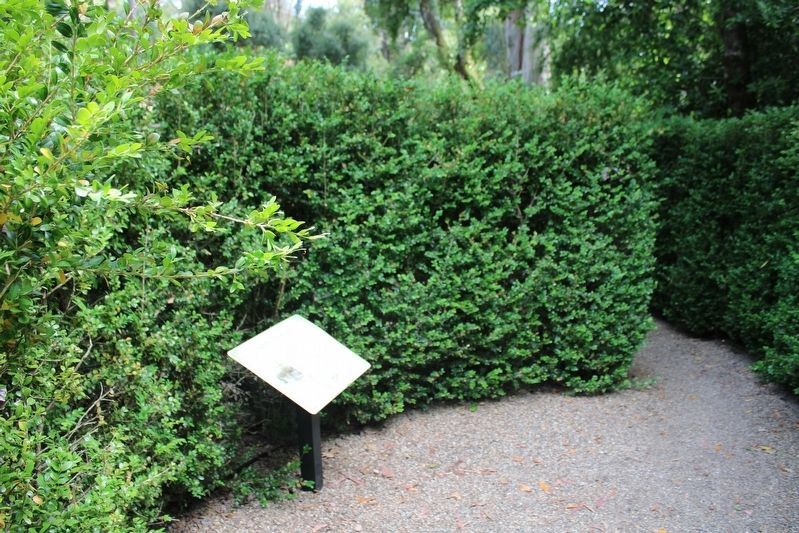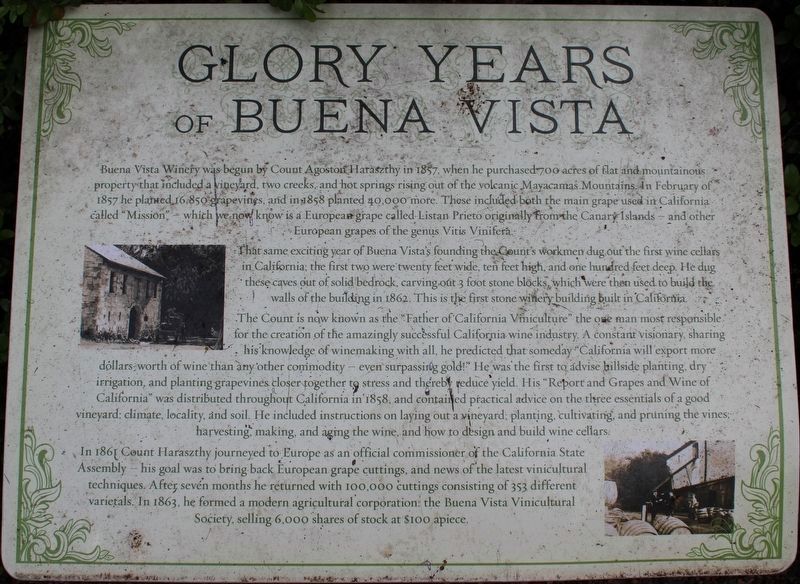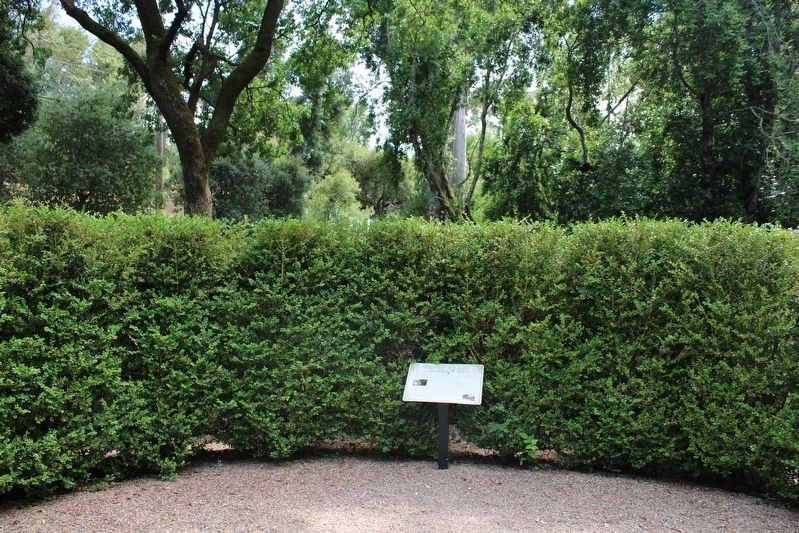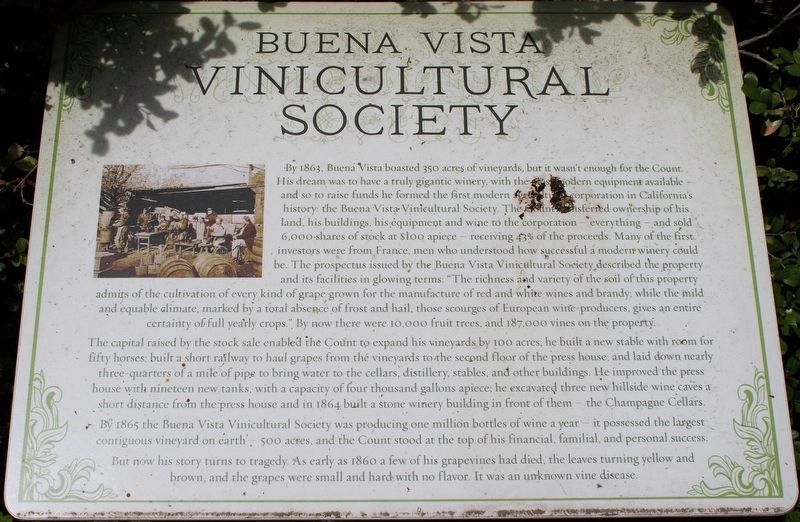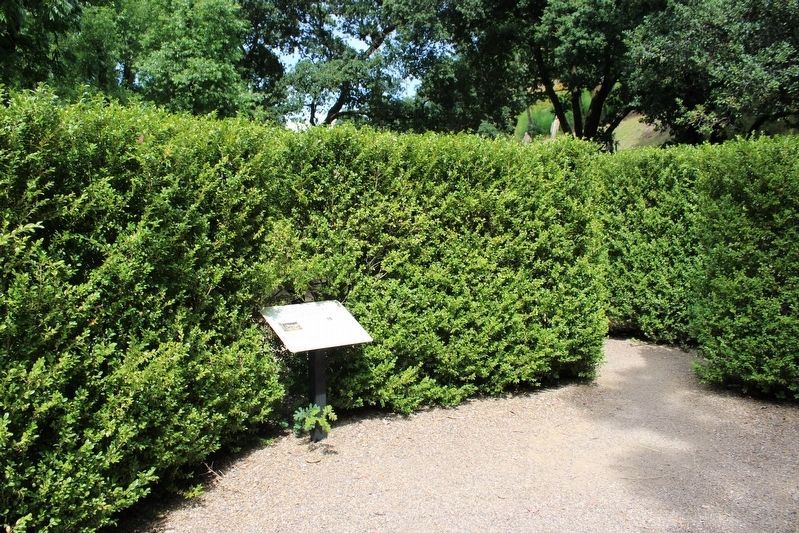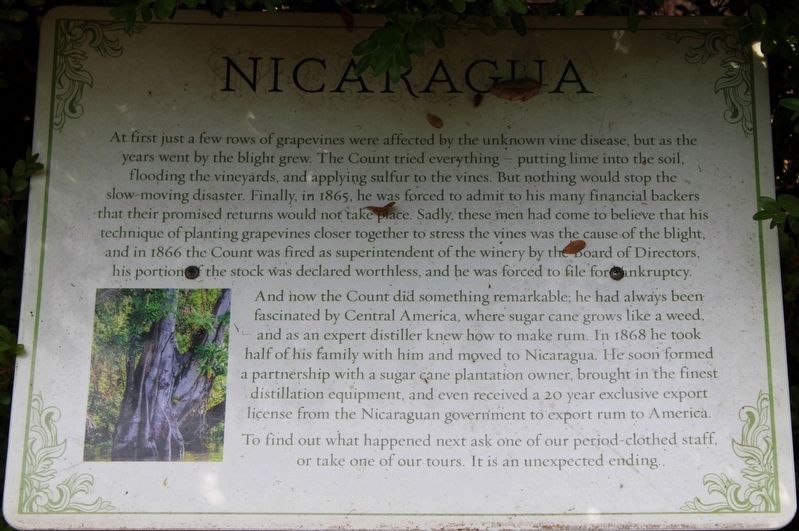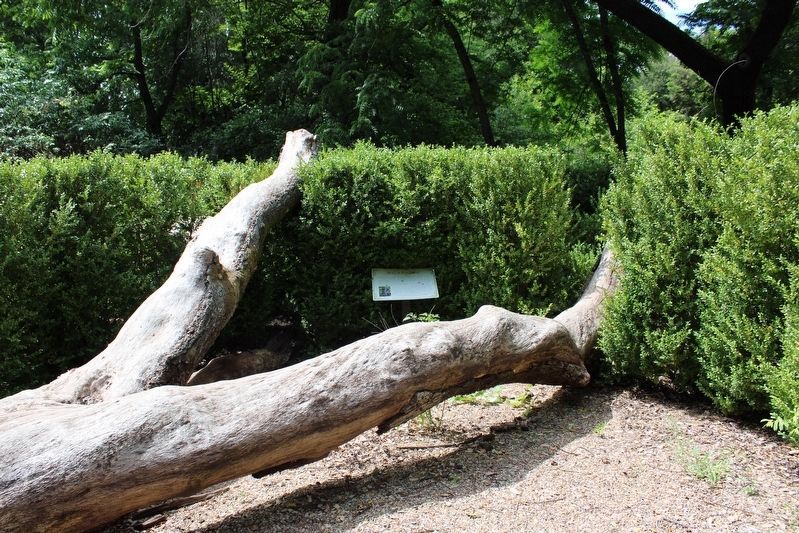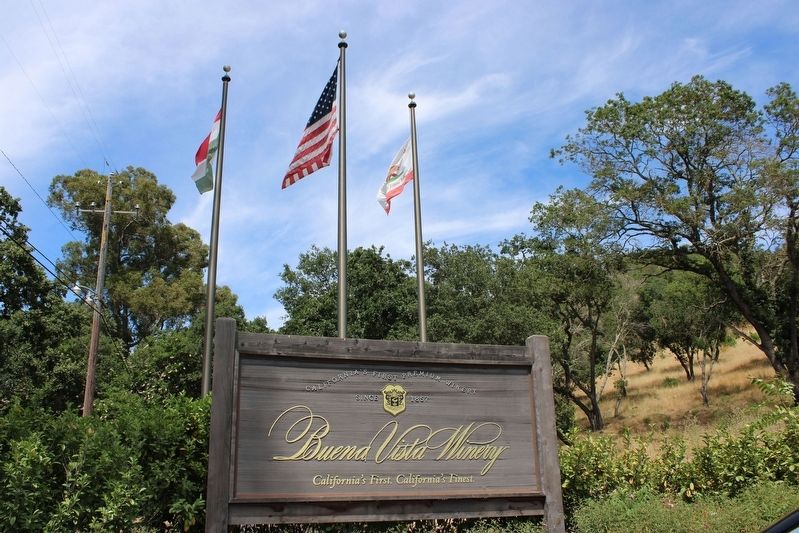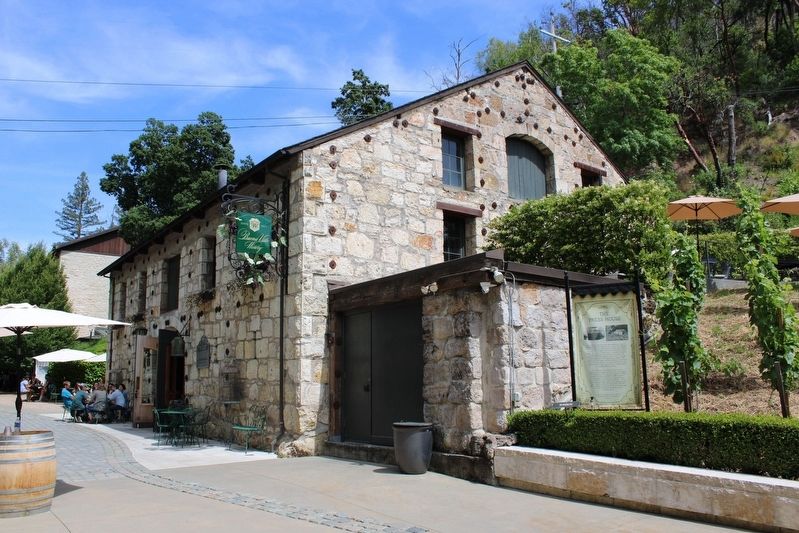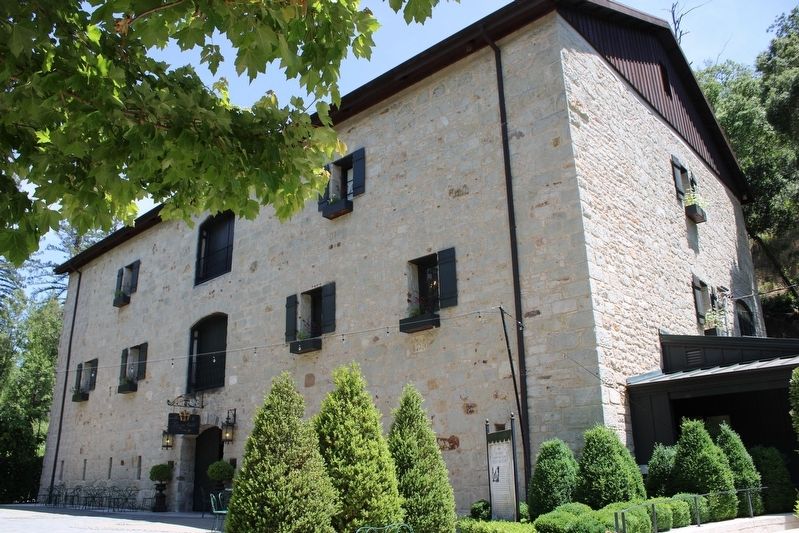Near Sonoma in Sonoma County, California — The American West (Pacific Coastal)
The Count's Journey Maze
Hidden within our maze are several private spaces; you may walk along our circuitous paths to find them. Inside these private spaces are signposts describing the astonishing life and journeys of Count Agoston Haraszthy, who founded our winery in 1857.
Marker Two:
Count Agoston Haraszthy was born in Pest, Hungary on August 30, 1812. As a member of Hungarian nobility, he learned to read and write in Latin, German, French, English, and Hungarian. Much of the Count's early life was spent making sure the family's varied enterprises were doing well: the raising of wheat, corn, barley, oats, cattle, and sheep, and growing grapes and making wine.
The Count had heard glowing tales of America: "The Land of Freedom and Opportunity" and in his own words described the difficulties of being a businessman and entrepreneur in Hungary - "where two or three blood-sucking monopolies held all of the business,"
In 1841 the Count and his family sold everything and emigrated to America with his father and mother: Karoly and Anna, his wife: Eleonora, and their three boys: Geza, Attila, and Arpad. The family first settled in Wisconsin.
Marker Three:
Upon arrival in Wisconsin the Count threw himself into a whirlwind of activity, purchasing land on the banks of the Wisconsin River. He laid out the streets of Haraszthy Town, and built a lumber mill to make wood planks for the houses he bought and sold. He had a grist mill, a brickyard, and a butcher shop to sell beef from his cattle herds, a stagecoach line, a ferry-boat across the river, and the first commercial steamboat line on the upper Mississippi and Wisconsin rivers. He piloted his steamboat Rock River on the Mississippi all the way to New Orleans on six different occasions. It was too cold for the grapevines he planted.
In 1848, gold was discovered in California, and when the exciting news reached Wisconsin the Count decided to journey to California to seek greater fortune in the gold fields. But he knew that "only a few people will find the gold lying around on the ground like chips." It was the "commercial possibilities" that convinced the entire family to leave for California on a wagon train in April of 1849.
Marker Four:
The Count had been intrigued by tales of the temperate climate of San Diego, and in December of 1849 his family arrived there after a nine month, 2,500 mile long adventure. He purchased land, planted grapevines, and on April 1st, 1850 was elected the first Sheriff of San Diego County. It was a difficult and dangerous job; his jurisdiction was almost as large as the current country of Hungary.
San Diego in 1850 was a lively town; hotels, saloons, and gambling parlors surrounded all edges of the central Plaza, serving the many travelers passing through as well as locals desirous of excitement. San Diego's first jail, built by the Count himself, was rarely empty long. After its completion, the citizens of San Diego passed new rules and regulations to officially calm their restive, adventurous citizens. Ordinances prohibited "riotous or disorderly noise by firing guns, pistols, or otherwise," and forbid the "slaughter of cattle, goats, or swine on the public streets.” The Count was often forced to pull his pistol on wrong-doers, and march them off to jail. In 1851 the Count was elected the first representative from San Diego to the California State Assembly, and in 1852 journeyed north to the City of Vallejo, across the bay from San Francisco.
Marker Five:
Buena Vista Winery was begun by Count Agoston Haraszthy in 1857, when he purchased 700 acres of flat and mountainous property that included a vineyard, two creeks, and hot springs rising out of the volcanic Mayacamas Mountains. In February of 1857 he planted 16,850 grapevines, and in 1858 planted 40,000 more. These included both the main grape used in California called "Mission” - which we now know is a European grape called Listan Prieto originally from the Canary Islands – and other European grapes of the genus Vitis Vinifera.
That same exciting year of Buena Vista's founding the Count's workmen dug out the first wine cellars in California; the first two were twenty feet wide, ten feet high, and one hundred feet deep. He dug these caves out of solid bedrock, carving out 3 foot stone blocks, which were then used to build the walls of the building in 1862. This is the first stone winery building built in California.
The Count is now known as the "Father of California Viniculture" the one man most responsible for the creation of the amazingly successful California wine industry. A constant visionary, sharing his knowledge of winemaking with all, he predicted that someday "California will export more dollars worth of wine than any other commodity - even surpassing gold!" He was the first to advise hillside planting, dry irrigation, and planting grapevines closer together to stress and thereby reduce yield. His "Report and Grapes and Wine of California" was distributed throughout California in 1858, and contained practical advice on the three essentials of a good vineyard; climate, locality, and soil. He included instructions on laying out a vineyard; planting, cultivating, and pruning the vines; harvesting, making, and aging the wine, and how to design and build wine cellars.
In 1861 Count Haraszthy journeyed to Europe as an official commissioner of the California State Assembly - his goal was to bring back European grape cuttings, and news of the latest vinicultural techniques. After seven months he returned with 100,000 cuttings consisting of 353 different varietals. In 1863, he formed a modern agricultural corporation: the Buena Vista Vinicultural Society, selling 6,000 shares of stock at $100 apiece.
Marker Six:
By 1863, Buena Vista boasted 350 acres of vineyards, but it wasn't enough for the Count. His dream was to have a truly gigantic winery, with the most modern equipment available and so to raise funds he formed the first modern agricultural corporation in California's history: the Buena Vista Vinicultural Society. The Count transferred ownership of his land, his buildings, his equipment and wine to the corporation - everything - and sold 6,000 shares of stock at $100 apiece - receiving 43% of the proceeds. Many of the first investors were from France, men who understood how successful a modern winery could be. The prospectus issued by the Buena Vista Vinicultural Society described the property and its facilities in glowing terms: "The richness and variety of the soil of this property admits of the cultivation of every kind of grape grown for the manufacture of red and white wines and brandy; while the mild and equable climate, marked by a total absence of frost and hail, those scourges of European wine-producers, gives an entire certainty of full yearly crops.", By now there were 10,000 fruit trees, and 187,000 vines on the property.
The capital raised by the stock sale enabled the Count to expand his vineyards by 100 acres; he built a new stable with room for fifty horses; built a short railway to haul grapes from the vineyards to the second floor of the press house; and laid down nearly three-quarters of a mile of pipe to bring water to the cellars, distillery, stables, and other buildings. He improved the press house with nineteen new tanks, with a capacity of four thousand gallons apiece; he excavated three new hillside wine caves a short distance from the press house and in 1864 built a stone winery building in front of them - the Champagne Cellars.
By 1865 the Buena Vista Vinicultural Society was producing one million bottles of wine a year- it possessed the largest contiguous vineyard on earth- 500 acres, and the Count stood at the top of his financial, familial, and personal success.
But now his story turns to tragedy. As early as 1860 a few of his grapevines had died, the leaves turning yellow and brown, and the grapes were small and hard with no flavor. It was an unknown vine disease.
Marker Seven:
At first just a few rows of grapevines were affected by the unknown vine disease, but as the years went by the blight grew. The Count tried everything - putting lime into the soil, flooding the vineyards, and applying sulfur to the vines. But nothing would stop the slow-moving disaster. Finally, in 1865, he was forced to admit to his many financial backers that their promised returns would not take place. Sadly, these men had come to believe that his technique of planting grapevines closer together to stress the vines was the cause of the blight, and in 1866 the Count was fired as superintendent of the winery by the Board of Directors, his portion the stock was declared worthless, and he was forced to file for bankruptcy.
And now the Count did something remarkable; he had always been fascinated by Central America, where sugar cane grows like a weed, and as an expert distiller knew how to make rum. In 1868 he took half of his family with him and moved to Nicaragua. He soon formed a partnership with a sugar cane plantation owner, brought in the finest distillation equipment, and even received a 20 year exclusive export license from the Nicaraguan government to export rum to America.
To find out what happened next ask one of our period-clothed staff, or take one of our tours. It is an unexpected ending.
Erected by Buena Vista Winery.
Topics. This historical marker is listed in these topic lists: Horticulture & Forestry • Immigration • Law Enforcement • Settlements & Settlers.
Location. 38° 17.945′ N, 122° 25.427′ W. Marker is near Sonoma, California, in Sonoma County. Marker can be reached from Old Winery Road east of Lovall Valley Road, on the left when traveling east. The metal markers are mounted throughout the maze. Touch for map. Marker is at or near this postal address: 18000 Old Winery Road, Sonoma CA 95476, United States of America. Touch for directions.
Other nearby markers. At least 8 other markers are within walking distance of this marker. Early California Heroes and the Gold Rush (a few steps from this marker); Heroes of 19th Century Science (a few steps from this marker); Mariano Guadalupe Vallejo (a few steps from this marker); Chinese Workmen at Buena Vista (a few steps from this marker); Chief Solano (a few steps from this marker); California Wine Heroes (a few steps from this marker); Heroes of Western Expansion (within shouting distance of this marker); Pioneer of the California Wine World (within shouting distance of this marker). Touch for a list and map of all markers in Sonoma.
Also see . . . Buena Vista Winery: The Entire Story. An expansive timeline of the winery's history. (Submitted on August 26, 2023, by Joseph Alvarado of Livermore, California.)
Credits. This page was last revised on August 26, 2023. It was originally submitted on August 26, 2023, by Joseph Alvarado of Livermore, California. This page has been viewed 67 times since then and 20 times this year. Photos: 1, 2, 3, 4, 5, 6, 7, 8, 9, 10, 11, 12, 13. submitted on August 26, 2023, by Joseph Alvarado of Livermore, California. 14, 15, 16. submitted on August 21, 2023, by Joseph Alvarado of Livermore, California.
